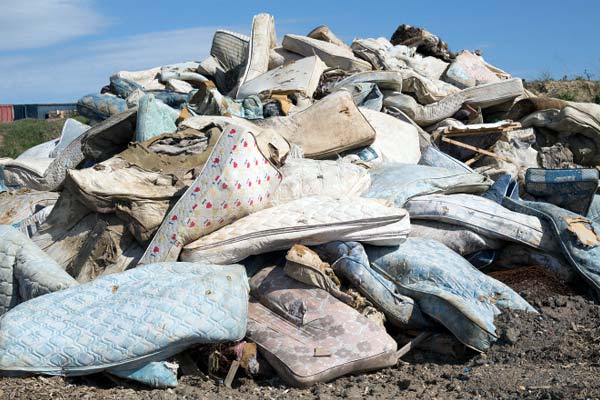In a world where environmental concerns are paramount, every decision we make matters. Even seemingly small choices, like what to do with an old mattress, can have a significant impact. In this article, we will delve into the crucial topic of “Landfills vs Mattress Recycling.” We’ll explore the differences between these two options, their environmental implications, and why choosing mattress recycling can lead to a greener and more sustainable future.
Landfills vs Mattress Recycling
When it comes to disposing of an old mattress, you essentially have two main options: sending it to a landfill or choosing mattress recycling. Let’s take a closer look at these two choices.
Landfills: A Wasteful Destination
Landfills are the traditional, but not necessarily the most eco-friendly, destination for discarded mattresses. Here’s what happens when a mattress ends up in a landfill:
- Long Decomposition Period: Mattresses are bulky and primarily made of materials that don’t break down easily. In a landfill, they can take decades, or even centuries, to decompose fully.
- Space Consumption: Mattresses occupy a significant amount of space in landfills, contributing to the rapid depletion of land resources.
- Toxic Chemicals Release: As mattresses deteriorate, they release harmful chemicals into the soil and groundwater, posing potential health hazards.
- Methane Emissions: Landfills produce methane, a potent greenhouse gas that contributes to climate change. Improperly disposed mattresses add to these emissions.
The Burden of Landfills
Old mattresses discarded in landfills pose a significant environmental problem. These bulky items take up substantial space and do not decompose easily. As a result, landfills quickly become overcrowded, leading to the need for more land to accommodate our ever-increasing waste. This land usage often encroaches on natural habitats, contributing to biodiversity loss.
Moreover, when mattresses decompose in landfills, they release harmful chemicals and greenhouse gases into the atmosphere, worsening air quality and contributing to climate change. These factors underline the urgency of exploring alternative disposal methods.
The Promise of Mattress Recycling
On the other hand, mattress recycling offers a sustainable solution. Recycling centers are equipped to dismantle old mattresses, separating materials like foam, fabric, and metal springs. These materials can then be repurposed into new products, reducing the strain on natural resources.
Not only does mattress recycling minimize waste in landfills, but it also cuts down on the environmental impact associated with producing new mattresses from scratch. This results in reduced energy consumption and greenhouse gas emissions, aligning with our global efforts to combat climate change.
Benefits of Mattress Recycling
- Environmental Preservation: Opting for mattress recycling reduces the burden on landfills and helps conserve valuable land and resources.
- Energy Efficiency: Recycling uses significantly less energy compared to manufacturing new mattresses, promoting energy conservation.
- Reduced Greenhouse Gas Emissions: By recycling, we contribute to a reduction in greenhouse gas emissions, helping combat climate change.
- Job Creation: Mattress recycling facilities provide employment opportunities within communities, boosting local economies.
- Positive Environmental Impact: Recycling old mattresses promotes a greener and healthier planet for future generations.
Mattress Recycling: A Sustainable Choice
On the flip side, mattress recycling is a much more sustainable option. Here’s why:
- Resource Conservation: Recycling mattresses allows for the recovery of valuable materials like steel, foam, and fabric. These materials can be repurposed for various uses, reducing the need for virgin resources.
- Reduced Waste: Recycling prevents old mattresses from taking up space in landfills, helping to extend the life of these disposal sites.
- Environmental Benefits: By choosing recycling, you contribute to reduced greenhouse gas emissions and the preservation of natural resources.
- Job Creation: The mattress recycling industry also creates job opportunities, stimulating local economies.
FAQs about Landfills vs Mattress Recycling
1. Is mattress recycling cost-effective?
Yes, mattress recycling can be cost-effective in the long run as it reduces disposal fees and conserves resources, leading to potential savings.
2. Can all types of mattresses be recycled?
Most mattresses, including innerspring, memory foam, and latex, can be recycled, but it’s essential to check with local recycling facilities for specific guidelines.
3. Are there any benefits to sending a mattress to a landfill?
While landfills may seem convenient, choosing recycling over landfills is generally more environmentally responsible and sustainable.
4. How can I find a mattress recycling facility near me?
You can search online directories or contact local waste management agencies to find a nearby mattress recycling facility.
5. What happens to a mattress during the recycling process?
Mattress recycling typically involves dismantling the mattress, separating its components, and processing them for reuse or recycling.
6. Are there any regulations regarding mattress disposal in my area?
Yes, regulations vary by location. It’s advisable to research and follow local guidelines for responsible mattress disposal.
Conclusion
In the battle of “Landfills vs Mattress Recycling,” the choice is clear: mattress recycling is the path to a greener and more sustainable future. By opting for recycling, you not only contribute to resource conservation but also reduce the harmful environmental impacts associated with landfills. It’s time to make informed choices for a better tomorrow, one mattress at a time.

